Last week, I was taking pictures of the bridge over 96th Street on Riverside Drive…
…when a detail caught my eye on the apartment building to the north…
This bit of decoration on the corner…
…featuring a buffalo skull with ceremonial decorations:
As I stared at it, I started to notice more interesting details, like two arrowhead spears flanking the skull…
…along with these very strange faces on either side:
Swinging around to the front of the building, I saw that the motif continued across the facade…
…with mountain lions (surrounded by Mayan and Aztec-inspired imagery)…
…a decorated buffalo head above the door, and even a couple of rattlesnakes if you look closely!
In fact, the entire facade is dripping with southwestern imagery. So why such a unusual theme for an art deco building in the middle of Manhattan? The answer can be found in the building’s name: The Cliff Dwelling.
In the early 1900s, people living in highrise apartment buildings were jokingly referred to as “cliff dwellers.” In 1916, when architect Herman Lee Meader, a devotee of Mayan and Aztec architecture, began designing 243 Riverside Drive, he decided to take the term literally and covered the facade with imagery inspired by Arizona cliff dwellers.
This southwestern deco combination results in some really interesting quirks, like this bit of ornamentation above the door…
…which once held a large metal and glass marquee to the building:
The Cliff Dwelling was originally an apartment hotel, offering one and two-bedroom suites to occupants wishing to stay longer than a typical hotel visit, but still having the freedom to leave at any time (fun fact: a struggling L. Ron Hubbard was a guest at the hotel in 1940, and after an argument with a steward of German descent, attempted to denounce him to the FBI as a Nazi enemy of the state). In 1932, kitchens were added and the building converted into housekeeping apartments.
Even in the brickwork, you can see the sort of patterns that one might find in, say, Navajo textiles.
The theme continues right up to the roof…
…with more zigzag patterns in the brickwork…
Look really closely, and you’ll even find several swastikas, a sacred Native American symbol that was once quite common prior to its corruption by the Nazis:
Was the interior as richly decorated as the exterior? I headed for the entrance…
Love the the font used for the etched address on the glass doors…
…especially the RSD portion:
Inside, a cast iron door features this beautiful pattern…
A close-up of the design:
But ready for the best part?
Seriously, how beautiful is that?
The floor is covered in a gorgeous pattern of reddish-orange, black, green and white tiles:
A close-up:
Meanwhile, I love how the bricks are clearly meant to have a somewhat rough-hewn feel, as though you might be in a sandstone dwelling. Below, the mailbox alcove:
The walls are accented with lines of symboled tiles:
The lamps overhead match the motif:
According to the NY Times, the lobby was once decorated in Navajo rugs and similarly themed furniture during its apartment hotel days.
Finally, there’s an equally great sitting room in one corner, with more of that southwestern tilework. Such a wonderful interior:
There’s one last unusual fact about 234 Riverside worth mentioning. If you go up to the north side of the building and peer through the fence, you’ll notice something odd…
The building is only nine feet wide! (those buildings you see are the Cliff Dwelling’s neighbor).
In fact, 234 Riverside is triangular in shape, narrowing down to a scant nine feet at its skinniest end. All of the building’s rooms face out onto Riverside (the apartments are said to be quite small; over time, many have been combined into larger units).
What a great building. Unfortunately, I couldn’t find a single historical record of the apartment hotel’s existence outside of a few address mentions – not even a newspaper ad or postcard. If anyone is able to, please email it along!
-SCOUT
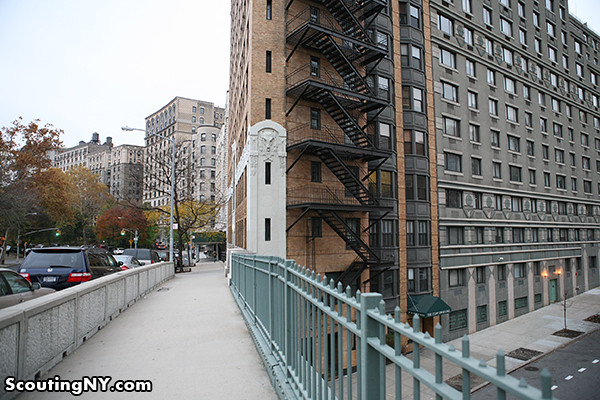




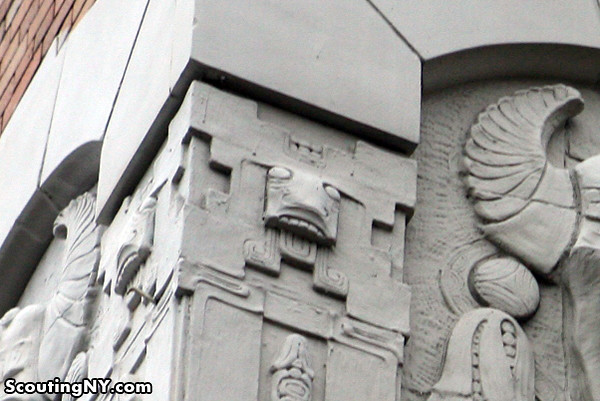

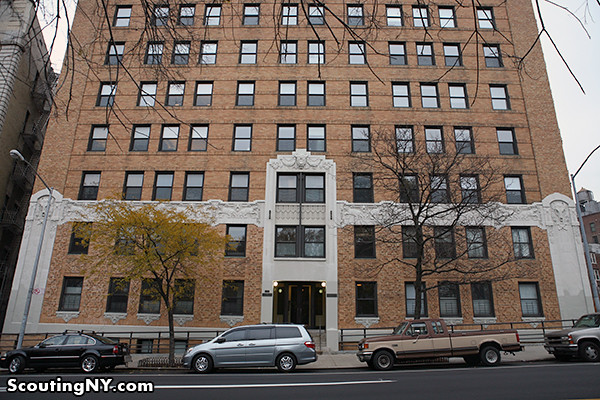
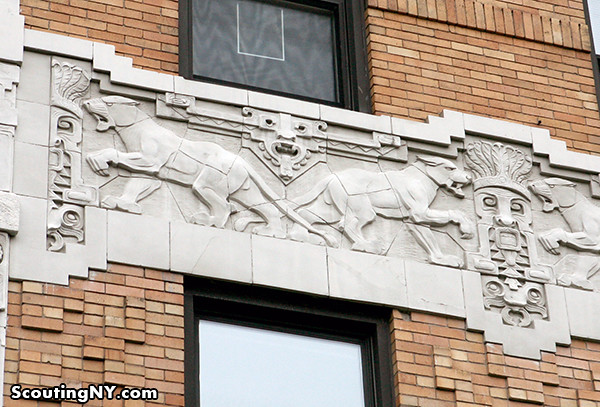
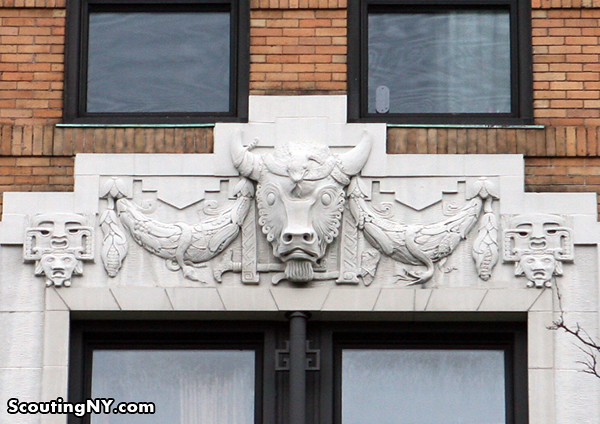
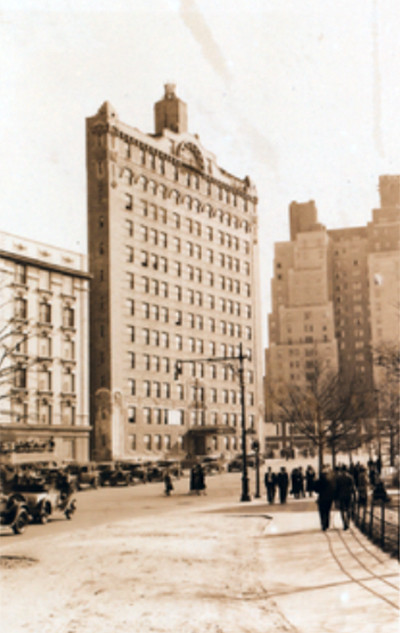
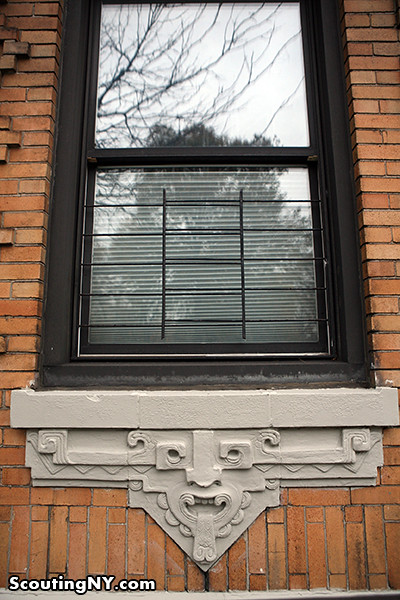




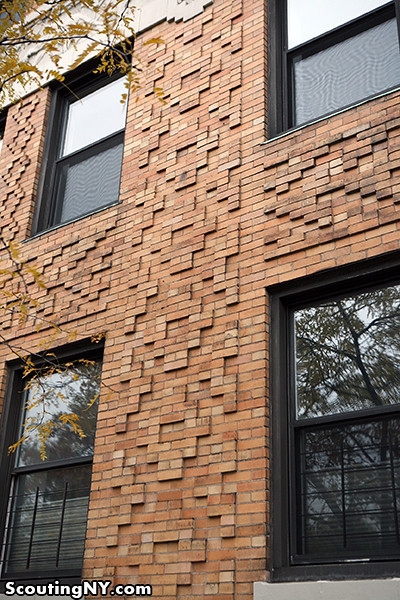
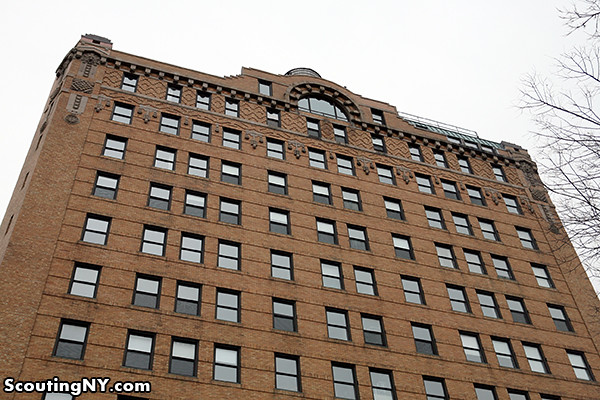
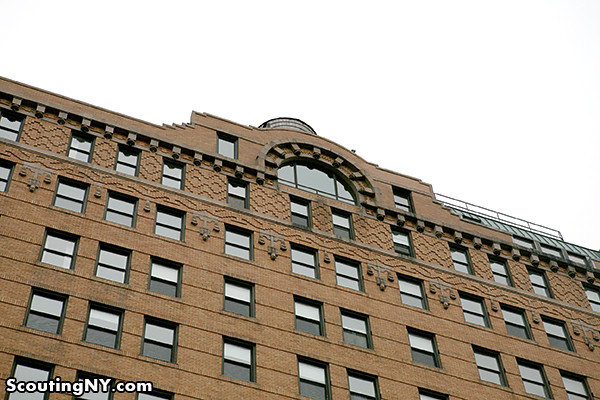


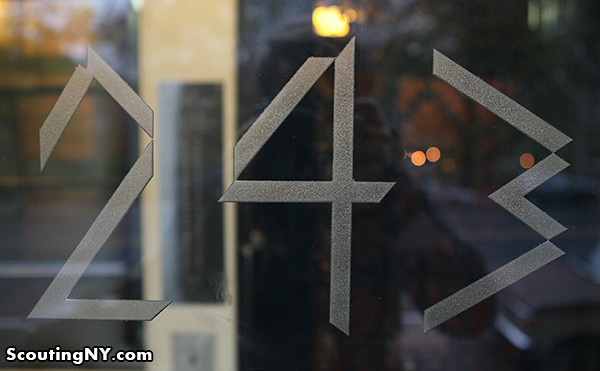


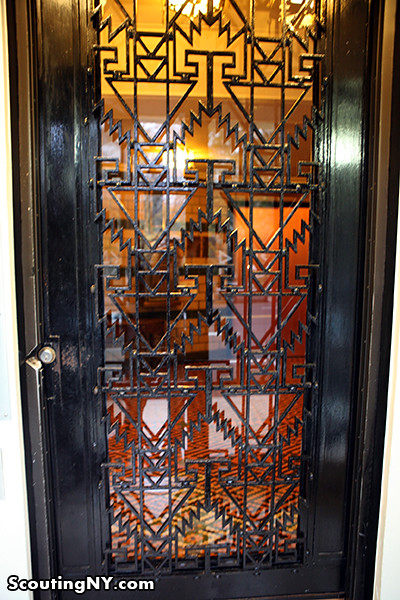
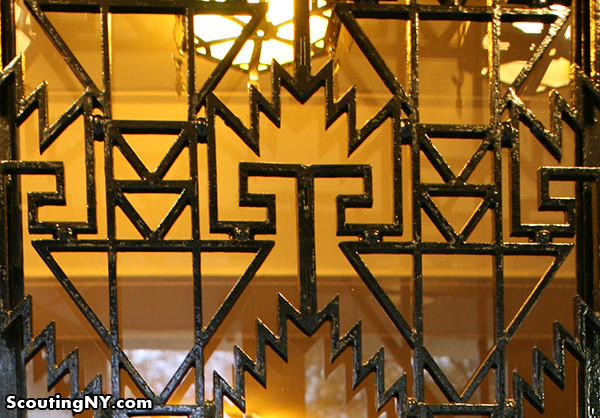

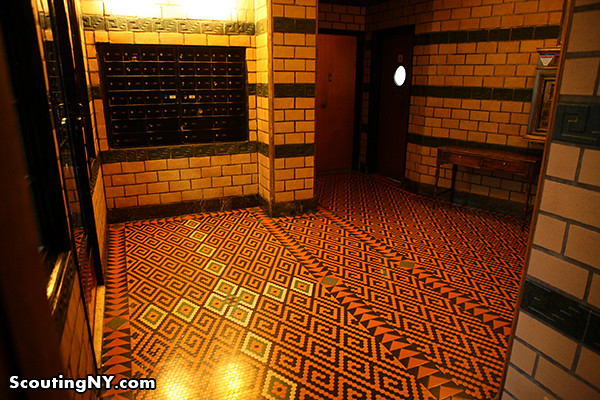
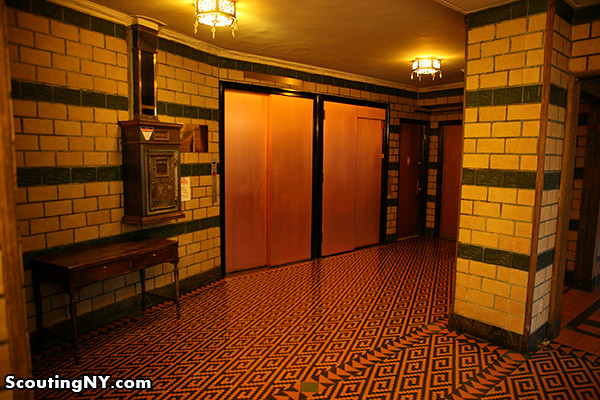
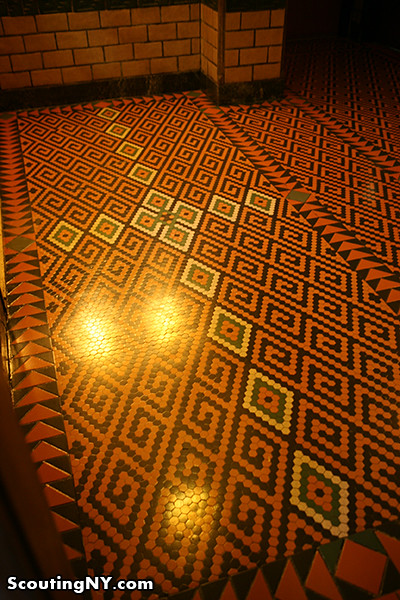
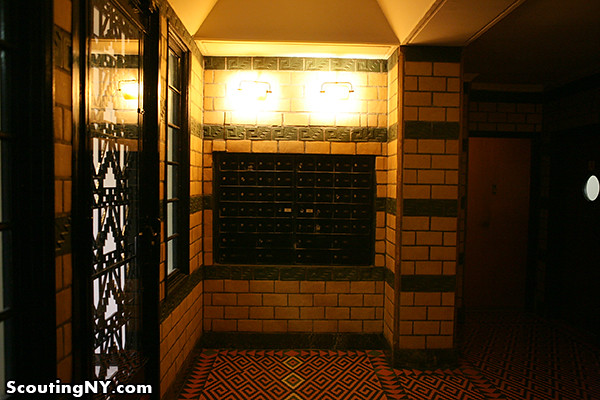
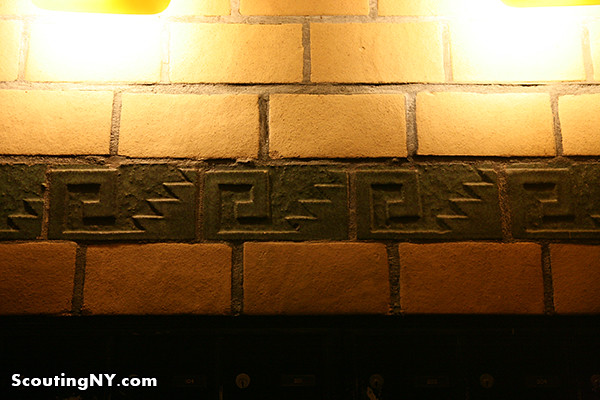
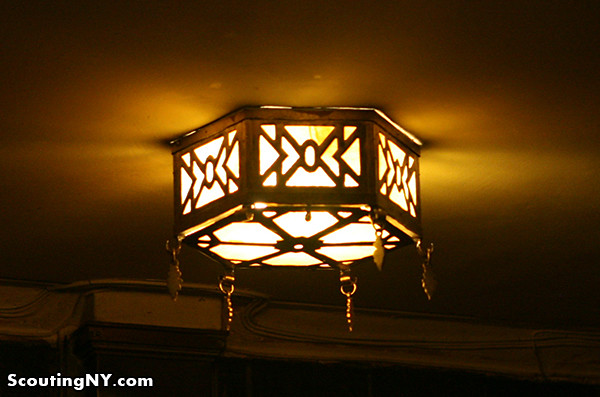
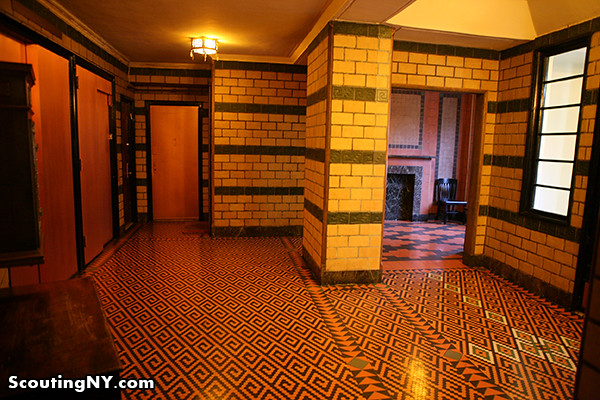

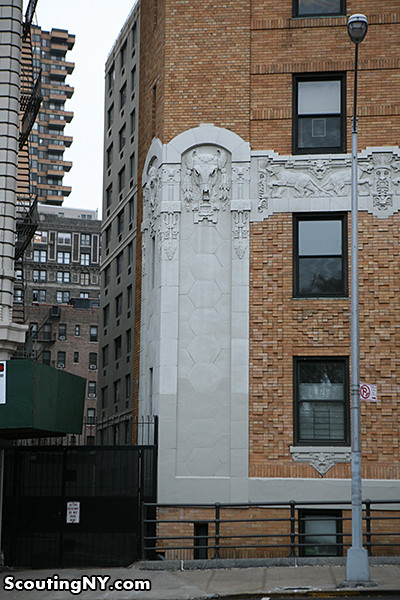
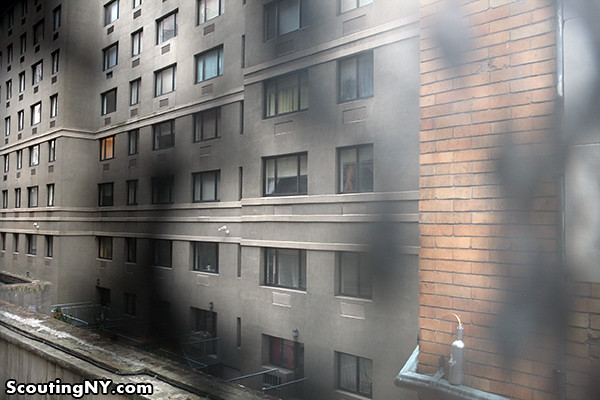
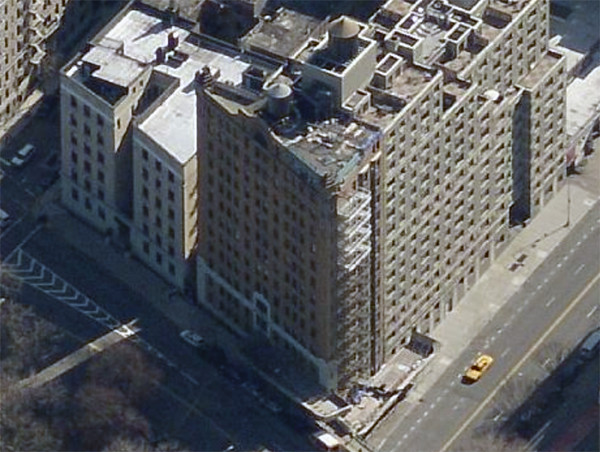

You have outdone yourself this time, Nick. Amazing history. I haven’t been to NYC in so long but I relive our early visits through your eyes. The research you did was so cool and I love the history behind all of this. Thanks for sharing. Hope the movie is coming along. I donated but hadn’t seen an update lately.
You refer to the skull as that of a Buffalo, but is it not rather a Bull? I can not zero in on a definite place of reference, but is not the Bull depicted over the door also similar to art found in Asian and possibly Buddhistic Indian Architecture? Wonderful discovery!!
I have always admired this building. How wonderful it is that you have added substance to the façade! And what a great façade it is. Thanks!
I userd to work near this neighborhood and always wondered about this building. I’m glad to know the details.
Nick,
These skulls are known as bucrania—sculpted decorative elements depicting oxen skulls that are relatively common in classical architecture. Nice adaption here of bucrania with the southwestern deco motif.
Here’s an example of the same element found in a Cass Gilbert-designed library in St. Louis:
https://www.flickr.com/photos/thelexiphane/14290030436/in/photostream/
Re: the arrows. They don’t have fletching on the end of them, these may be spears instead of arrows
Like an urban Overlook Hotel.
My husband Jerome designed the 243 RSD for the front door in about 1979-80 — soon after the building went co-op. He was never happy with it — he only had a weekend to come up with something. He moved in in 1978. I think he was the last person in as a renter. The building was in bad financial shape and the tenants organized and purchased it from the company that owned it. The grill work on the front door came from the passenger elevator when it went from manned to automatic. The building just redid both elevators in 2009. Jerome help design them also to stay in keeping with the existing design.
The square column in the center of the lobby was fabricated in 2009 to match the original tiling in the lobby. Underneath are very ugly pipes. If I remember correctly the pipes are just encased in plywood and dimensionally painted to match the rest. I have many photos.
I also have some newspaper articles about “The Flatiron on the Drive”. It was started in 1914 and was built as a residential hotel to get around code — the plot of land, which had previous been used for advertising billboards, was large enough for air shafts, which were required in apartments buildings. Each room had outward facing windows!
I’ll see if I can dig up the main newspaper article and more photos.
Jerome reminded me that the ironwork from the elevator that is now in the front door was turned upside down for more dramatic effect. The other iron grill work remained on the freight elevator until the new elevators went in in 2009. 2008?
The lettering on the doors — when Jerome moved in they had plain glass door with traditional gold leaf numbering. The building wanted something more in keeping with the original design of the building. Jerome’s friend Nina, who also lived in the building, designed the iron 243 RSD on the 96th St entrance.
Also the last paragraph, I meant to say the build wasn’t large enough for air shafts. It was also more of a single room occupancy hotel — long-term residential that short term. People lived there for years and took their meals in the mezzanine
More info, courtesy of Christopher Gray’s’ NYT Streetscapes column — I thought I remembered reading about Navajo rugs being in the lobby when it first opened: http://tinyurl.com/pt42jhq
Are those floor tiles hexagon tiles? If so I really want to make a quilt based on this pattern. I may have to go visit this building so I can take detail photos of the floor!
This is very pretty, but what a strange combination of symbols and styles. Aztec and Mayan art is Central American– not really interchangable with art coming from the Southwest done by the Navajo and Pueblo. Sort of a mishmash that’s a bit jarring if you know Native American art. Still, pretty though.
I love this building! I just brought a friend by to see it a couple of weeks ago, four days before you posted this.
The buffalo skull is based on the bucranium, a classic iconographical image in Greek antiquity:
http://en.wikipedia.org/wiki/Bucranium
I’d never seen the inside, though–thanks for those beautiful, beautiful lobby shots.
“Unfortunately, I couldn’t find a single historical record of the apartment hotel’s existence outside of a few address mentions – not even a newspaper ad or postcard.”
Duly noted.